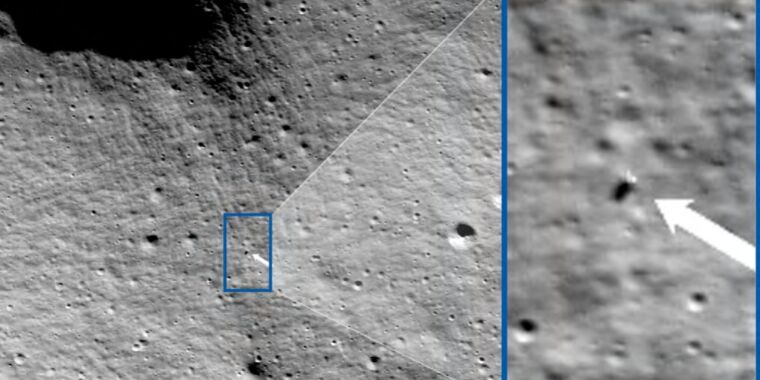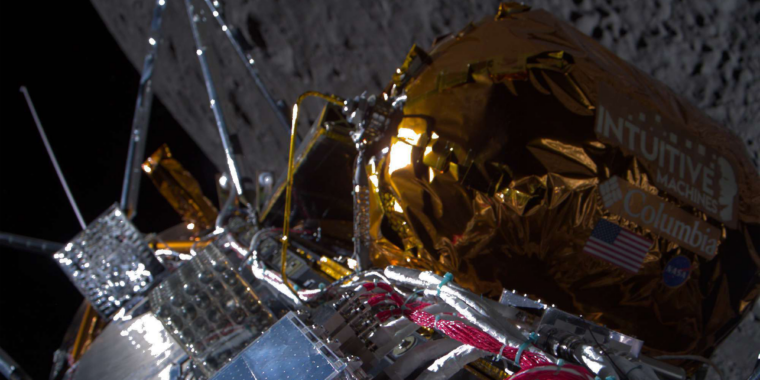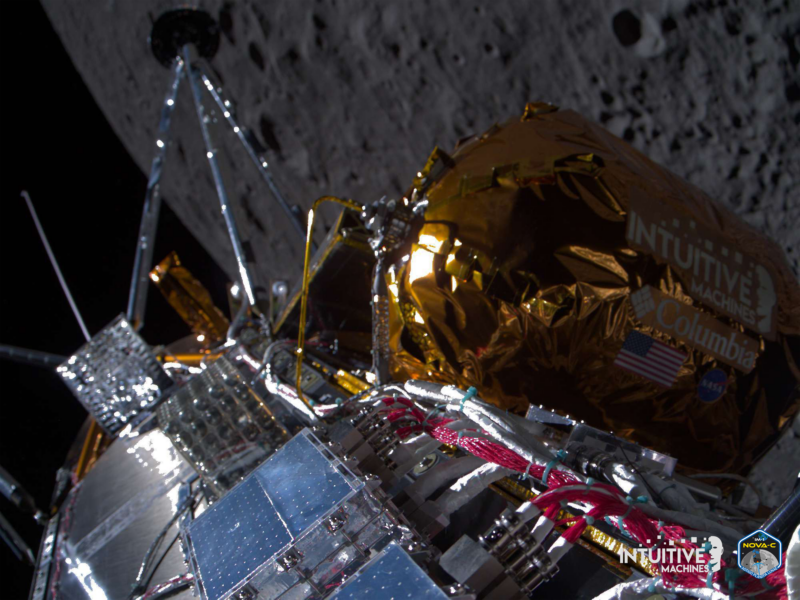Odysseus has less than a day left on the Moon before it freezes to death
Phoning home —
So what are we to make of this? Is Odysseus a success or a failure?
NASA/Goddard/Arizona State University
Time is running out for the historic Odysseus lander that made a soft touchdown on the Moon last Thursday evening.
In an update posted on Monday morning, the company that built the spacecraft, Intuitive Machines, said, “[W]e believe flight controllers will continue to communicate with Odysseus until Tuesday morning.” This is because the lander, which is tipped over on its side, will only be able to collect solar energy for a limited period of time.
Originally, the company had hoped to operate its privately developed lunar lander on the surface for a week or longer. But now, that will no longer be possible due to the limited ability of Odysseus to gather solar energy and remain powered on. As the Sun dips closer to the horizon, and with the two-week-long lunar night coming, the spacecraft will, effectively, freeze to death.
On its side
The shorter-than-anticipated lifetime is due to the lander’s position on the surface. On Friday, during a news conference, Intuitive Machines’ chief executive, Steve Altemus, said the company believed Odysseus had come down to the lunar surface in a vertical configuration, as anticipated.
However, for reasons that Altemus did not entirely explain, the lander came down a bit faster than anticipated—6 mph (2.7 m/s) instead of 2 mph (0.9 m/s). Still, this pace, about the same as a moderate walk, was within the tolerances of the vehicle’s landing legs and structures to withstand. The problem is that the vehicle also had a lateral motion of about 2 mph, when it was supposed to come straight down.
Thus, as the vehicle descended to the Moon, it is possible that one or more landing legs may have been snagged by the lunar surface before the vehicle touched down. “It might have fractured that landing gear and tipped over,” Altemus said.
Based on the information available, the vehicle is lying horizontal but somewhat elevated off the ground. Intuitive Machines knew this, Altemus said, because the solar panels on the sides of the vehicle were able to gather solar power. This meant the body of the vehicle had to be somewhat raised above the surface. It’s possible, therefore, that the top of the vehicle tipped over onto a small boulder.
Enlarge / The Nova-C lander, named Odysseus, has solar panels on its sides as well as at the top of the vehicle.
Lee Hutchinson
Altemus said on Friday that the company was attempting to orient a solar array at the top of the vehicle to gather sunlight in addition to the panels on its side.
It seems like this operation was unsuccessful, as the lander’s solar arrays will only be able to gather enough energy to operate through Tuesday morning.
Data desired
Intuitive Machines received a valuable assist from a NASA spacecraft orbiting the Moon, the Lunar Reconnaissance Orbiter, which flew over the landing site this weekend. From this imagery, NASA was able to determine a precise landing spot for the vehicle: 80.13 degrees south latitude, 1.44 degrees east longitude, at an elevation of 8,461 feet (2,579 meters).
Notably, the spacecraft landed in a crater where the terrain was sloped at 12 degrees, which may have contributed to its tipping over.
During the news conference on Friday, Altemus and the company’s chief technology officer, Tim Crain, said they expected to be able to conduct most of the science missions on board the lander despite its sideways configuration. “Best guess, we expect to get most of the mission data down once we stabilize our configuration,” Crain said.
However, at the time, the company was still planning to operate the lander through this week. It is unclear that there will be enough time to get all of that data down between now and Tuesday morning. The company did not provide any updates on this on Monday.
A success, or no?
Another critical question is whether operators will be able to download images of Odysseus on the surface of the Moon. To date, Intuitive Machines has not published photos from the Moon’s surface. There remains some hope, however, that a CubeSat camera developed by students at Embry Riddle, EagleCam, will be deployed and activated before Odysseus‘ power runs out.
So what are we to make of this? Is Odysseus a success or a failure?
The mission has achieved some notable firsts. No privately developed spacecraft has ever made a soft landing on the Moon before, and it is important that Intuitive Machines has been able to maintain contact with the lander for several days. And at 80 degrees south, no spacecraft has ever made a soft landing so close to a lunar pole.
Although Intuitive Machines is not going to achieve all of the mission’s objectives, getting down to the Moon in one piece was, unquestionably, the achievement by which Odysseus and its builders should be judged.
Odysseus has less than a day left on the Moon before it freezes to death Read More »


